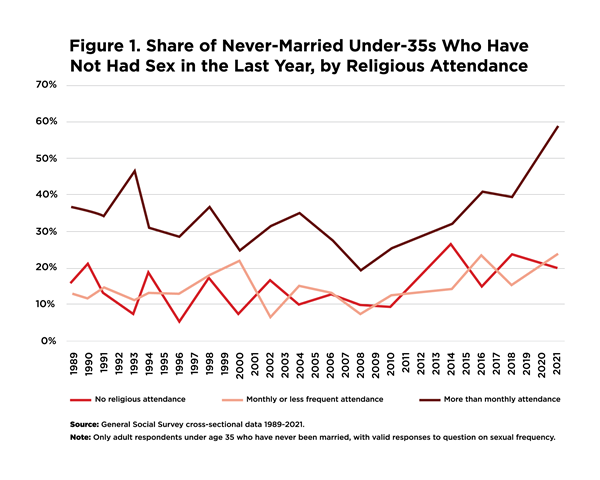Religious worldviews and attitudes may be a key motivation for abstaining from pornography, viewing premarital sex as wrong, and refraining from sex until marriage.
So does religious behavior correlate with sexual abstinence? The answer is yes.

While there has perhaps been a modest increase in sexual abstinence among religious nonattenders or occasional attenders, the lion’s share of the increase in sexlessness has been among the relatively religiously devout. Since 2008, among never-married individuals under age 35 who attend religious services more than monthly, the rate of sexlessness has risen from about 20% to nearly 60% in 2021. Among their less-religious peers, sexlessness has risen from around 10% in 2008 to 20% in 2021.
Since at the very least, most religious communities in America view premarital sex as a less preferred sexual arrangement than marriage, the increase in sexual abstinence among religious young adults could speak to an important change among religious communities.
It could be that Americans who deviate from religious sexual norms are finding it harder to stay attached to religious communities, as the cultural differences between religious and nonreligious worlds become larger. In this scenario, as nonreligious American culture becomes more sex-positive, the tension with religious norms becomes more intense, and people who deviate from those religious norms leave the church. This would imply that for many people, a key motivating factor in their religious behavior is sex.
But another explanation is that the behavior of religious people themselves is changing. Perhaps religious young adults are simply complying with the norms of their communities more determinedly than previous generations. In this scenario, we aren’t seeing religious young people change their metaphysics to validate sexual liaisons, but rather, we’re seeing religious young adults adopt more intense behavioral norms than prior generations.
In reality, both stories are probably true. Doubtless, changes in American culture writ large have made religious norms harder to square with day-to-day life for young people spending more and more years without a spouse, and some young adults have decided that the cost of compliance with religious sexual norms isn’t worth paying, as declines in church attendance may indicate.
Among adults under 35 who have never been married, the share who are frequent religious attenders fell from over 30% in the early 1990s to under 20% today. But while significant, these changes in religious attendance have been far too gradual to explain the whole trend observed in sexlessness.
In particular, there has been essentially zero change in religiosity among unmarried young adults in the GSS sample since 2008. So while compositional changes may matter, the behavior of religious people has changed too. This would seem to indicate that the current generation of religious young adults is more scrupulous about avoiding premarital sex than the last generation or two.
Increasingly delayed marriage has a large and well-understood effect on sexual frequency among American adults. But the rise in sexlessness among unmarried adults is not as well understood. If the data from the General Social Survey is to be believed, a key part of this story of changing sexual behavior in America is a change among religious people, or others, who believe premarital sex is wrong.
Increasingly, religious young adults are “practicing what they preach,” adopting a distinctive set of sexual behaviors. As a result, the growing diversity and polarization that typifies so much of American life is reaching even further—even into bedrooms.
Lyman Stone is a research fellow at the Institute for Family Studies, chief information officer of the population research firm Demographic Intelligence, and an adjunct fellow at the American Enterprise Institute.
This research was excerpted with permission from a recent article published at the Institute for Family Studies blog.
- Complete access to articles on ChristianityToday.com
- Over 120 years of magazine archives plus full access to all of CT’s online archives
- Learn more


